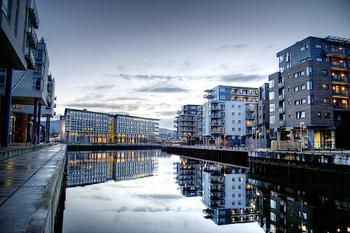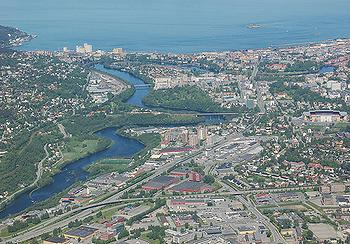挪威的 (Trondheim)市與貝羅納基金會(Bellona Foundation)和德國工程巨頭西門子(Siemens)公司聯袂,打算在不影響該城市人口的高生活水平之下,削減該城市20%的能源使用量。使之成為一個「智能城市」--名符其實的「智能電網。」
(Trondheim)市與貝羅納基金會(Bellona Foundation)和德國工程巨頭西門子(Siemens)公司聯袂,打算在不影響該城市人口的高生活水平之下,削減該城市20%的能源使用量。使之成為一個「智能城市」--名符其實的「智能電網。」
擔任該項位於挪威西岸中部260,000人口的城市計劃,貝羅納(Bellona)能源部門負責人布倫沃爾(Ane Brunvoll)表示:「這是個前所未有的創舉。」
她表示:「全球的主要城市只佔地表0.4%的面積,但卻佔了全球溫室氣體排放量的80%。因此,都會區才是提高能源使用效率最具潛能的地方。」
源於奧巴馬政府,按美國官方的說法,「智能電網」和「智能技術」即是靈活運用多方供電單位的配電網,並從電網上選擇最便宜的供電來源取電。
擧一個家庭的用電分配為例,洗衣機可能使用太陽能來供電,而燈和電視機則可能使用來自傳統的水利發電厰的電源。
這種智能電網的設計還考慮到不同電源各自不盡理想的地方。例如無風的日子,風力發電將由太陽能或生物質能熱力發電機來補足。
 的智能城市能源效率報告書目前正在編寫中。屆時報告中將呈現特隆赫姆如何透過使用智能能源的應用,達到減能耗的效果。這個作法背後的目的是希望能將目前正在特隆赫姆規劃進行的「智能城市」建立成為日後全世界發展類似計劃的楷模。
的智能城市能源效率報告書目前正在編寫中。屆時報告中將呈現特隆赫姆如何透過使用智能能源的應用,達到減能耗的效果。這個作法背後的目的是希望能將目前正在特隆赫姆規劃進行的「智能城市」建立成為日後全世界發展類似計劃的楷模。
特隆赫姆計劃的模式將著重於以下5個領域:建築、工業活動、生產與配電、靈活性和街道照明。
開闢公開網站是該計劃的一個亮點設計。該網頁開放讓一般家庭和企業可以自行上網註冊,進一步獲取更有效率使用能源的信息。
西門子公司位於特隆赫姆市的區主任和地方負責人弗勒塞特(Otto Froseth)表示,「採用目前坊間流通的技術,在不改變其市民生活水平的情況下,像特隆赫姆這樣的城市就可省下多達20%的能耗。」
特隆赫姆市的一名官員奧特薇克(Rita Ottervik)表示:「我們未來2、3年的目標,就是接受本市在特隆赫姆智能城市之能源使用效率報告書(Energy Effectiveness Report for Trondheim SmartCity)中所繪製的大幅節能藍圖的挑戰了。
{本文經貝羅納環境基金會許可轉載。挪威語至英文譯者為迪格斯(Charles Digges)}
The city of Trondheim, in cooperation with the Bellona Foundation and German engineering giant Siemens, will cut its energy use by 20 percent without a loss to the population of their high living standard, making it a "Smart City" - an apparent nod to the buzz phrase "Smart Grid."
"This is a pioneering project," said Ane Brunvoll, Bellona's energy department head of the plan for the central Norwegian city of 260,000 on the country's west coast.
"The world's major cities cover only 0.4 percent of the Earth's surface, but account for 80 percent of the world's greenhouse gas emissions. Therefore, cities are where you find the biggest potential or making energy use more effective," she said.
In American political parlance born of the Obama Administration, "Smart Grids" and "Smart Technology" are electrical distribution grids that run off a variety of power production units and are geared toward drawing power from the cheapest available energy sources that are linked to the grid.
A single household, for instance, might run a clothes washer from a solar energy source, while lamps and televisions might use power distributed from hydro-electrical sources.
Such smart grids are also intended to anticipate where weaknesses of various power sources will occur. For example, wind power would be compensated for by solar power or biomass thermal electric generators on still days.
The energy effectiveness report for Trondheim Smart City is under preparation and will show how Trondheim can reduce its energy consumption through the application of smart energy use. The idea is that a number of "Smart Cities" will be established worldwide on the model now being developed in Trondheim.
The Trondheim model will focus on five chief areas: construction, industrial activity, production and distribution of power, mobility and street lighting.
An important part of the project is the project's website, where ordinary households and businesses can register themselves to get information on how they can use energy more intelligently.
"By adopting technologies that already exist, a city like Trondheim can save as much as 20 percent on energy consumption without any need to change its standard of living," said Otto Froseth, Siemens' division director and local head in Trondheim.
"In the course of the next two or three years, the objective is to take up a significant part of the energy savings potential we have mapped out in the Energy Effectiveness Report for Trondheim SmartCity," said Rita Ottervik, a Trondheim official.
{Translated by Charles Digges, republished with permission from Environmental Foundation Bellona}





